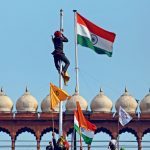The Man Who Would Be Mahatma
Would Gandhi still be interesting if he’d never made it to India in 1914? Ramachandra Guha answers: ‘absolutely.’
 Devika Bakshi
Devika Bakshi
 Devika Bakshi
|
15 Oct, 2013
Devika Bakshi
|
15 Oct, 2013
/wp-content/uploads/2015/11/P30-31-1.jpg)
Would Gandhi still be interesting if he’d never made it to India in 1914? Ramachandra Guha answers: ‘absolutely.
’The relish with which Ramachandra Guha talks about history is infectious. In his two-volume biography of Mohandas Karamchand Gandhi—the first part of which, titled Gandhi Before India, was released on the anniversary of Gandhi’s birth this year—Guha brings an almost literary approach to a historical figure obscured and restricted by his portrayals, fleshing out the man, his peers and his time, and offering a sort of reboot for the interested Gandhi agnostic.
In your book, you point to a ‘tendency among biographers and hagiographers [of Gandhi] to magnify [his] role and personality’. Many recent biographies have also sought to puncture holes in the halo around him. Is there a middle ground? What is your approach?
My approach in this book is to present a much more detailed and wide-ranging study of Gandhi, based on a wide variety of sources that people have not used; to look at him in the context of his relationships. Those who either magnify or diminish his role focus on him exclusively, essentially [using only] his collected works. But I think the important task for a biographer is to see his subject within the web and network of his relationships with family, associates, rivals, colleagues; if he is a writer, to study the evolution of his writing, and Gandhi is also a writer; to look at the larger social context, [which] in this case means bringing in the histories of India, South Africa, and Britain…
South Africa… in this time is a fascinating country, finding its way. It’s been colonised from Europe, from India, there’s a kind of racial order being built, there are various independent provinces coming together in a kind of all-White union against the subjects, and the Boer War happens in the middle of all this. Clearly, previous biographers of Gandhi haven’t looked at this historical context, they’ve… only focused on Gandhi, been rather cursory, and seen it as a prelude to what happened [later in India]. What I’ve tried to do in this book [is] not about debunking or praising; it’s about providing a fleshed-out understanding of the man, his times, his associates.
What new aspects of Gandhi, what new material do you bring to light in the book?
There’s lots and lots, including the characters—they’re very important. I wrote a piece in the Financial Times times two weeks ago, [‘Gandhi’s Formative Years’, 20 September 2013] which… was about the laws of biographical writing. One of the laws I’ve arrived at through my studies is that a biography is only as good as its portrait of the secondary characters. And the secondary characters of his South African phase are incredibly fascinating in their own right. They shape and mould him too, but they are forgotten. We know about the characters of his Indian phase; we know about his political followers like [Vallabhbhai] Patel and [Jawaharlal] Nehru, his spiritual followers like Mira Behn [Madeline Slade], and his antagonists like [Muhammad Ali] Jinnah and [BR] Ambedkar. But there were people in South Africa who… have never been mentioned; their photos have never been seen. The Gujarati merchant Pranjivan Mehta [for instance], who I argue was the Engels to Gandhi’s Marx, his first funder, his patron, his closest friend, his interlocutor, and someone who had deep and abiding trust in him—the first person to call him a ‘mahatma’. They had a friendship of over 15 years, which is very important in this book. [Also important is] this radical couple called the Polaks [Henry and Millie]—a Jew married to a Christian feminist—what it meant to be living in the same household as the Gandhis, an interracial household in the 1900s in Johannesburg, and how this mutual interaction shaped them…
It’s through the interactions with these people that he develops, broadens his outlook on religion and society. He [becomes] more aware of discrimination along the lines of caste and gender, he forges his philosophy of non-violence, he acquires a certain courage because people are willing to follow him, he develops his skills as a writer and a propagandist running Indian Opinion [a weekly journal representing the Indian community in South Africa, printed in four languages—English, Gujarati, Hindi and Tamil]. This may be the first biographical study of Gandhi to look at the entire run of Indian Opinion. As I say somewhere in the footnotes, I had some 40,000 words of notes on Indian Opinion. It gives you a sense of what he was like, as a writer, organiser, propagandist and fundraiser. So you get a much fuller portrait of these aspects.
…There’s somewhere he says—I don’t quote it in this book because he says it in the 1920s, [writing] to his secretary Sonja Schlesin, who’s also an important figure in this book—‘I’ve had no friends of the kind I had in South Africa, I don’t have associates of that kind.’ Because in India he had disciples and he had adversaries. [The people in this book] are colleagues, comrades, interlocutors, housemates, fellow jailbirds…
Thambi Naidu is a very interesting man in this book, a Tamil activist who helps save the [satyagraha] movement after the Gujaratis back out; he gets the Tamils on board. [This is how] Gandhi discovers the heterogeneity of India; he doesn’t know the linguistic, religious, social diversity of his own homeland. And what he discovers in South Africa, through his engagements and relationships, helps him in his political practice in India, too.
We know that when Gandhi came back to India and started getting active in the Congress, one of the first things he did was to persuade the Congress to reconstitute their provincial committees as linguistic committees—not the Bombay Presidency committee, but a Marathi committee and a Gujarati committee. This is a very important fundamental learning that comes from South Africa. He says often, ‘I want to learn Tamil.’ He doesn’t succeed. Then he tells his nephew: ‘You learn. You must.’ He reaches out to the Tamil people; he starts a Tamil section of his newspaper…
The lesson I’ve learnt over many years is that secondary characters are crucial. It’s in situating Gandhi in relation not just to the broader historical context of colonialism and the making of the South African apartheid state, but also to those he is seeing on a daily basis—interacting with, arguing with, debating with, mobilising, persuading, cajoling, and sometimes oppressing, as in the case of his children—that you understand the man.
Clearly, for a fiction writer, this is very important. You can’t write a novel about one person. Or if you do, you have to draw in all these relationships. But biographers generally underplay this. Certainly, biographers of Gandhi have… So [this book] is a story about multiple people, with Gandhi at the centre. These other people shaped him and formed him, and yet they are forgotten. I’ve tried in this book to try and give them their proper place.
Why didn’t these relationships carry over more significantly into his Indian phase?
Well actually, that’s interesting. One of them wanted to come with him: [Hermann] Kallenbach, who was his closest follower. Of course that’ll be in the sequel. This book ends with Gandhi taking the ship back… What happened is, Gandhi, Kasturba and Kallenbach left Capetown in July 1914 for India, but they went to London because Gokhale, [Gandhi’s] mentor, was there, and [Gandhi] wanted to consult him on what he should do when he comes back. As they are going to England, war breaks out between England and Germany. Kallenbach is of German origin, so he is interned as an alien on the Isle of Wight, and is not allowed to come with Gandhi to India.
The Polaks came several times… Later on, there’s an estrangement, on politics. One of the issues was they were rooted in South Africa. He corresponded with them, but Gandhi, from very early on, knew he had to come back. Pranjivan Mehta is very important because he is the first person to call Gandhi the Mahatma, and [as early as] 1904-05, he recognises Gandhi’s importance and is telling him: ‘you have to go back to the motherland. That’s where there’s a much larger theatre for your work, and the motherland needs you. It needs a patriot and an organiser and a spiritual being like you to rescue and redeem it.’
So Gandhi, after the first decade in South Africa, knows that this is not going to be his home forever. He has to stay there till such time as he can guarantee the Indians there a certain modicum of rights. He knows he will never get them full citizenship, because of the racist regime at that stage, but certain rights of property, of ownership, of the freedom to practice our own trade, [freedom] from certain discriminatory laws [that didn’t] allow you to go out at night, freedom to move from one province to another—all these were restricted. He understands that one all this is done, he will have to go back…
Now, why he doesn’t have similar associations [in India] is that he’s already established [when he returns]; he’s 45, he’s completely clear about what he wants to do. One of the things that comes through in this book is his inner confidence—later on. Early on he’s a young man who meets a lot of hostility from the White press—and there’s lots and lots of new stuff here about the depth of the hostility, the anger of the White press against Gandhi, a young man of 25, 26, 27, facing vicious abuse. I quote some satirical poems abusing him in the press, cartoons, physical attacks where he’s almost beaten to death. But over a period of time, once he combats that, finds his feet and develops his philosophy, and finds that thousands of people follow him into jail, there’s a certain inner confidence that develops.
He’s a very confident man. He’s writing to [Leo] Tolstoy in 1909—he is 40; Tolstoy is the world’s greatest writer. And in a sense, though the term was not used then, by 1909 Tolstoy had given up novel writing for 15 years, and was the world’s greatest public intellectual. By far. And Gandhi was writing to him—an obscure lawyer in South Africa—saying… ‘Our struggle in the Transvaal is of world historic significance.’ He’s writing to Tolstoy, saying, ‘Your method I’ve tried here and this is the best and most fully-realised articulation of [it].’
The point is that when he comes to India, he has already, through all of these encounters, developed a confidence and certitude. Which is why he only has disciples and adversaries.
He does have one friend [who I’ll discuss further] in my second volume: his secretary Mahadev Desai, who is Gandhi’s closest associate, and who wrote himself out of the Gandhi story—who was more important to Gandhi than Nehru and Patel, and who had a more equitable relationship with Gandhi. But because he was with Gandhi all the time—they talked half a dozen times a day—there is no written record. There are hardly any letters between them. But that’s a separate story.
Essentially, by the time Gandhi leaves South Africa, he is pretty clear that he’s an important figure who’s going to reshape and transform the history of his country; not the history of the world, but at least the history of his own country.
You say biographers of Gandhi have done ‘injustice to both man and place’ by choosing to ‘consider his life in teleological terms,’ resulting in front-heavy narratives that emphasise the freedom struggle and his impact in India and ‘skip hastily over’ the South Africa phase of his life. But it almost seems as if his life had an inbuilt teleological bent, as everyone around him and he himself began to feel relatively early that he was headed for a huge—global—role.
Yes, later on, that’s true… But when I decided to make this a two-volume biography—it was originally going to be one volume, but I found so much new material on the South African period, and all these papers of Polak and Kallenbach and so on, that I decided to make it two—I said let me write it on the assumption that the ship, which is carrying him from Capetown to India in 1914, sinks: is Gandhi still interesting?
Of course he’d be interesting. He’d be interesting because of South Africa at that time, and the peculiar position of Indians between Africans and Whites, which then later played out through the struggle against apartheid. [His time in South Africa] is interesting because that’s where he develops his, in my view, really original and incredibly relevant ideas of religious pluralism that are quite distinct from atheism and religious fundamentalism, which are the dominant strands today.
He’s interesting because of his nonviolent struggle and how he articulated it, how he theorised it, how he positioned it as an alternative to armed struggle and to acquiescence. Because essentially, if you were upset with the British, you wrote petitions saying, you know, ‘Please treat us better,’ or you took the armed struggle route of Aurobindo Ghosh and so on. [Gandhi] elaborated in South Africa an alternative, which was quite efficacious in an instrumental sense, but also, in his view, had a moral underpinning.
I tried to write [about this period] keeping both haste and teleology at bay, so I’d give it the attention it requires, I’d develop a narrative at a slow pace, not rushing through it… not anticipating, trying to understand events as they unfold, without any conscious awareness of what happens to him after he comes back to India. Obviously, you can’t completely succeed in this—the book is called Gandhi Before India—but it doesn’t tell you what happened later.
When did Gandhi develop a sense that he was headed for ‘big things’?
After thousands of people followed him into jail. Not till then… In the Transvaal, there were—there’s no precise estimate—less than 10,000 people, probably 9,000. 2,700 went to jail. So you’re talking about 30 per cent of a population courting arrest. What this means is that he’s inspired them personally. It’s a small community, so he knows many of them… He goes [to jail] four times [and gets the sense that] other people are willing to make the sacrifice too. That, I think, gives him a kind of confidence that he can have a defining impact on the community…
There are two chapters that are very important in the making of Gandhi, which are in this book: when he goes to London in 1909, followed by the writing of Hind Swaraj. When he goes to London, Madanlal Dhingra has just killed Curzon Wylie, and he finds the Indian students [there] agog with excitement, thrilled by it. Publicly they can’t say it, but they think this is the way to kick out the British, and they see it as an act of daring and heroism. Gandhi is appalled; he sees it as a cowardly act. An Englishman has come as a guest to a reception of Indian students and you shoot him. He sees it as reprehensible [in] a moral sense, but he’s very dismayed by how many Indian students are attracted by it.
So… though he has the inner confidence that you mentioned, he also recognises that to promote nonviolence among young men [is no easy task]. Young men are prone to, as we can see around us today, large and fanciful ideas of what can be done quickly, through very dramatic means. He does recognise this; it’s not as if he underestimates the challenges he will face to promote nonviolent protest in India… Certainly, he thinks he’s going to have a world historic role—he says it to Tolstoy— but he recognises that it’ll be a major struggle when he comes back.
What did it take to create a ‘global social movement’ at this time—before mass media, before it became easy to be visible?
It is quite striking… One of the greatest surprises in this book was to find how well Gandhi was known in India…Gandhi [had] organised a satyagraha in 1907-08 and then a major protest in 1913-14 where thousands of Indians breached the provincial boundaries and the women also went to jail—Kasturba led the women satyagrahis—and this was reported in the Indian press.
There’s something called the ‘Report on Native Newspapers’ that the British used to maintain. After the Swadeshi movement in India in 1905, the British [were] very fearful of sedition, so they started translating [local news] reports. They appointed translators for every province, so there’s a Report of Native Newspapers [from] Madras, Bombay, Punjab, Bengal, etcetera… Week by week, they’d select the most seditious or dangerous comments, translate them, and flag them to the attention of the authorities. I wondered [if they had] reported Gandhi’s movement. And I found unbelievable stuff. Like regular reporting on mass meetings held in all kinds of towns [in South Africa], 30-40 towns, and the later satyagraha in 1913.
I found a copy of a Telugu play, in the colonial archives, about Gandhi, representing him as a kind of Rama figure fighting this injustice, written in Masulipatnam [now Machilipatnam], a coastal town in Andhra—Gandhi had not even been to Andhra Pradesh; in 1913, he had not been to India for 10-12 years. And yet, there was such an extraordinary interest in his movements in the Indian press. That was an extraordinary revelation to me—that the struggle in the diaspora attracted so much attention, sympathy and excitement in India…
Something about that might have reached Gandhi, because Gandhi was an assiduous reader of newspapers. The stuff about the White prejudice and the hostility to Gandhi is based on newspapers he collected, which are at the Sabarmati Ashram. So how it happened in an age before internet—of course, Indian Opinion the newspaper was coming, the deportees were coming. Deportees came to Madras and told stories of the sacrifice of their leader. This was communicated by word of mouth all across Andhra, Kerala, Karnataka. It’s really very interesting.
There’s a beautiful phrase from a Kannada newspaper in Mysore, where they’re describing Gandhi’s movement and [they say] that he is conducting ‘the obsequies of unrighteousness’. It’s a beautiful phrase. To think of satyagraha as the attempt to conduct the obsequies of unrighteousness.
You talk about this as the origin of diasporic nationalism which was becoming very powerful at the time. But there is now a sense that the Indian diaspora should not participate to any great degree in Indian politics.
The difference, of course, is that the debates of the diaspora today are dominated by the prosperous middle- [and] upper-class diaspora in the US. The diaspora that Gandhi represented were hawkers, labourers, waiters in restaurants, petty traders, itinerant merchants—it was a very different kind of diaspora… The Indian diaspora in America is a strange thing because they went from being elites here to being elites there—they’re unique in the history of diasporic movement. So there is that major difference, I think.
What was the significance of the role played by Indians in South Africa, where there were two sets of colonisers with a single agenda against the native population, an agenda which, in a way, came together as a response to the mobilisation and agitation initiated by Gandhi?
It’s a very complicated situation. Somewhere [in the book] I say that Indians in South Africa were a confusing, complicated factor. Because elsewhere you had Whites and Browns or Whites and Blacks, but here you had this intermediate category, and Gandhi [was] the symbol, the representative, the leader, the articulator of who they [were] and what they [wanted]… It’s unique, because there’s the Dutch and the British, and they finally come together against the Indians and the Blacks.
In this period, the Indians are the only effective economic competitors and challengers to the Whites. The Africans are in the countryside—they’re herders or farmers or whatever. And so the Indians become the guinea pigs of the first laws, because you don’t want them to be educated, you don’t want them to go to English language schools, you don’t want them to compete with you in trade, you don’t want them to have the freedom to migrate, to seek opportunities—‘there’s nothing in Natal, I’m going to Transvaal’—you don’t want [Indian] doctors, lawyers, professionals. In that sense, the laws are aimed against [Indians], and Gandhi starts fighting them.
Of course, there’s a very interesting question as to Gandhi’s relationship with the Africans. Through the book, I show a slow evolution of his views. He starts with the conventional prejudices of an Indian upper-class man—there are the Europeans; the Indians are almost there, they also have an ancient civilisation; and the Africans are kind of raw and naked in the forest. But slowly, he evolves. He stops calling them ‘kaffirs’, he understands [the] discrimination [against them], he empathises with them… The African National Congress is partly inspired by what he does. And you see later on [that] his evolution, [after] his return to India, goes further and further. By the ’30s and ’40s, he’s promoting a truly inclusive non-racial politics, where he says, ‘we have to have equality of Whites, Blacks [and] Browns in South Africa…
I [originally] had a 10,000 word epilogue [in the book] about Gandhi and South Africa, from 1914, when he leaves, till today—what he said and did in the ’20s and ’30s; his close contacts with Indians [in South Africa] fighting apartheid; his influence on the African National Congress, which till the ’50s was led by Gandhians. There was a major struggle in 1952 called the Defiance Campaign, in which Mandela also courted arrest, which was nonviolent, and totally inspired by Gandhi. Of course, later on the ANC gives up nonviolence, [but] then re-embraces the Gandhian ethic of reconciliation after the end of Apartheid.
[Gandhi] is a community organiser; he is not a universalist fighter for human rights. But… in 1909 he gives a speech where he says, ‘Satyagraha will be a weapon for the African population, too, for their own rights. But they have to work out their own path; I am an Indian representing the Indians.’ So he’s clear about his limited objectives. It’s very easy to cherry-pick Gandhi… You quote him from 1895, he’s saying, ‘the raw kaffir in his indolence,’ and you say he’s against Blacks. Likewise, when you come to his ideas on untouchability, in 1919 he says untouchability is bad, but varnashrama dharma is good, and you say, ‘Oh, he’s defending the traditional caste order!’ But by the 1920s and 30s, he has evolved, and by the 1940s, he has totally rejected varnashrama dharma, and he says, ‘the only marriages in my ashram will be between a Dalit and a upper-caste [person]’.
The great thing about Gandhi is how he evolves his views. He is an incrementalist who is open to change and modification, and in South Africa, with South Africans, you can see this clearly. It’s anachronistic for us, in 2013, to say, ‘Why didn’t he take up the African cause?’ Because he was there as a diasporic leader and he knew what he had to do. But over a period of time, he came to recognise the depth of the Africans’ suffering, and to advocate political means such as satyagraha to them too—not that he would lead it; an African leader would lead it.
It is sometimes felt that Gandhi’s role in Indian history is overstated.
That may be true. There were some great figures in our modern history who may not have got their due because of Gandhi. And only now are slowly getting their due. A very important illustration of this is Ambedkar, [who]was a considerable figure whose interest and importance was not recognised [till] the 50s and 60s…
Having said that, Gandhi, in my view, is not an Indian [but] a global thinker. And that’s what distinguishes him from Ambedkar—and Jinnah and Patel and Nehru and Savarkar and Bhagat Singh, and whoever else may be your favourite Indian nationalist. Because of his extraordinary technique of nonviolence, his ideas of religious pluralism, his precocious environmentalism and all of that, Gandhi is a universal thinker. You don’t have to agree with him, but his ideas have a universal reach…
Why does President Obama say I want to have dinner with Gandhi? Why did the resistance to Communism in Eastern Europe invoke Gandhi? Gandhi has a kind of universalist appeal, which, for a historian, makes him much more than an Indian figure. It may be true that in Indian history we have magnified his role. I’m willing to accept that. But his thought, his practice, his legacy has a reach way beyond India, which you can’t say about other people.
—In conversation with Devika Bakshi
About The Author
CURRENT ISSUE
Rashmika Mandanna: India’s Sweetheart
MOst Popular
4

/wp-content/uploads/2025/04/Cover-Rashmika-New.jpg)











More Columns
The Legacy of Manoj Kumar Madhavankutty Pillai
India received a heads up from US on tariffs Rajeev Deshpande
Saving Farmers from the Unions Siddharth Singh